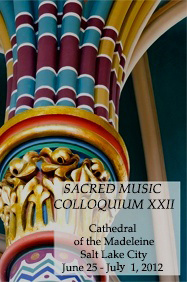The distinction between religious music and liturgical music (cf. part one of this series) embodies this double movement: religious music is, we might say, the earthly expression of a given culture's faith in Christ; liturgical music is the sacramental expression of Christ and the true nature of the Church. The former tends to be particular, individual, temporal and profane; the latter tends to be universal, communal, eternal and sacred. Religious music comes from human hearts yearning for God; liturgical music comes from Christ's heart, the heart of the Church, longing for us.
...
Some might ask: should not the mention of the word assimilation give us pause, or even make us somewhat nervous? If we submit ourselves to this assimilation — with all our musical preferences, tastes, and cultural differences — to the concrete musical sources of the Church's liturgy (i.e., the Roman Missal itself, Graduale Romanum, Graduale Simplex, vernacular translations and adaptations thereof, etc.), will we not entirely lose ourselves, our individuality and creativity? Is there not a danger of the Church becoming irrelevant and therefore powerless in her liturgical expressions, a mere museum of "old" music?
To answer these concerns, we could extend the Church's teaching on the new translation to the use of liturgical music: "So the liturgy of the Church must not be foreign to any country, people or individual, and at the same time it should transcend the particularity of race and nation. It must be capable of expressing itself in every human culture, all the while maintaining its identity through fidelity to the tradition which comes to it from the Lord" (Liturgiam Authenticam, 4).
In other words, the Church, though existing in many cultures, has her own authentic culture because she has authentic liturgy… both which come to her from Christ. The unity and integrity of the Roman Rite is embodied in the Rite's sacred texts and musical forms, as a vine is expressed in its branches. Growth requires pruning and nourishing, but never ignoring or starting from scratch.
http://www.chantcafe.com/2012/02/bishop-olmsted-singing-mass-part-iii.html
Subscribe to:
Post Comments (Atom)

No comments:
Post a Comment